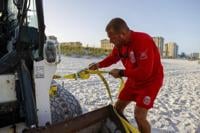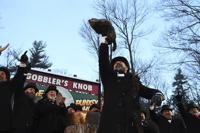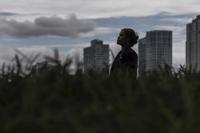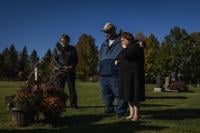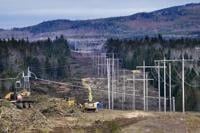WASHINGTON (AP) — As tens of thousands of soldiers stormed French beaches during the D-Day landings of World War II, 2nd Lt. John Arthur Finnegan was on duty in a mess hall half a world away on the northeastern coast of Australia.
As President commemorates the 80th anniversary of D-Day in France on Thursday, he will be thinking of the millions of young U.S. service members who answered the call to serve and defend the U.S. in World War II -- including Finnegan and three other uncles. While none were among the thousands who came ashore on June 6, 1944, they supported the war effort in other ways. One made the ultimate sacrifice.
Japan's deadly sneak attack on Pearl Harbor in Hawaii in December 1941 was a galvanizing moment in the United States, retired Army Col. Michael Bell said during a telephone interview from France, where he had traveled for the celebrations.
“Immediately, there's a sense that war's come to America,” said Bell, executive director of the Jenny Craig Institute for the Study of War and Democracy at the ������ϲʹ������� World War II Museum in New Orleans.
“The day after Pearl Harbor my mom's four brothers went down to sign up for war service,” Biden wrote in his memoir, referring to uncles Gerard, Edward, Ambrose and John, who registered at the local draft board in their hometown of Scranton, Pennsylvania. “Three of them got in.”
In the book, Biden speculated that his uncle Edward, who went on to become a traveling Serta mattress salesman, was rejected by the Army because of the “terrible stutter” he had his whole life.
John Finnegan, 21, and Ambrose Finnegan, 27 joined the Army Air Corps in January 1942 and were sent to Officer Candidate School in Australia. John Finnegan had quit his job as assistant manager and chief usher at a movie theater in Scranton, according to his Official Military Personnel File, which the ������ϲʹ������� Archives and Records Administration shared with The Associated Press.
The personnel files for tens of thousands of U.S. service members who served in the Army during World War II were destroyed in a warehouse fire in the 1970s and little could be learned about Gerard Finnegan's service beyond the president's reference in his memoir to that uncle.
Ambrose Finnegan perished in the war just weeks before D-Day.
Ambrose, or “Bosie,” as the family called him, was a courier who died on May 14, 1944 — Mother's Day — while a passenger on an Army Air Forces plane that, “for unknown reasons,” was forced to ditch in the South Pacific Ocean off the northern coast of New Guinea, according to the Pentagon's .
“Both engines failed at low altitude, and the aircraft’s nose hit the water hard,” the agency says in its listing about Finnegan. “Three men failed to emerge from the sinking wreck and were lost in the crash.” Finnegan and the others were presumed dead. His remains were never recovered. Gen. Douglas McArthur sent a letter of sympathy to Finnegan's family.
Biden misstated a few facts when he related the story in April, saying his uncle's plane was “shot down” in an area “where there were a lot of cannibals in New Guinea at the time.” The U.S. government's record of service members missing in action does not attribute Finnegan’s death to hostilities nor does it indicate that cannibals were a factor.
Biden, 81, was a toddler at the time of his uncle's death. He recently made his first visit to a World War II memorial in Scranton, and traced the inscription of Ambrose Finnegan's name with his finger.
In his remarks in Scranton about “Bosie,” he referred to those who served as “the guys who saved civilization in the 1940s.”
As the Finnegan and Biden families in Pennsylvania mourned Ambrose's death, John Arthur Finnegan was half a world away managing his own grief. He and older brother Ambrose had joined the military together, with a photograph of the siblings and a mutual friend appearing in a local paper the day before they all joined.
John Finnegan belonged to the Army’s 8th Service Squadron, stationed in Townsville, Queensland, Australia, which was responsible for performing maintenance and supply work to support the Pacific campaign at bases in nearby New Guinea, according to Bell.
The squadron's daily “company morning report” for June 5, 1944, the day before D-Day, showed 2nd Lt. Finnegan had been assigned to “Add dy Sq Mess O vice 1st Lt Billingsley Reld.” Translation: He had been tasked with supporting Reld in the squadron mess office, possibly performing such functions as inspecting dining operations, reviewing paperwork and accounting, and figuring out future rations, Bell said.
“In this case, he's going to go inspect the mess hall,” Bell said. “He could have been assigned that for a day or two. Likely, he's assigned that as an additional duty.”
Finnegan left active duty in November 1945 and was honorably discharged from the Air Force Reserves in November 1961. Along the way, he had returned home to Scranton, earned a bachelor's degree in sociology and a master's degree in psychology from the University of Scranton and had worked in the school registrar's office and as a clinical psychologist at Delaware State Hospital in Wilmington. He also had married and had children, his military personnel records show.
John Arthur Finnegan died in March 1973 at age 52. Biden was among Finnegan's pallbearers.
Biden had an uncle on his father's side of the family who also served during WWII. Frank H. Biden entered the Army in July 1941, several months before the attack on Pearl Harbor, and was discharged in 1945.
In addition to Biden's uncles, Donald Jacobs, the father of Biden's wife, first lady Jill Biden, also entered the military during the war. Jacobs was 17 when he joined the Navy in November 1944, after D-Day, and became a Navy signalman.
___
AP Researchers Jennifer Farrar and Randy Herschaft in New York contributed to this report.












